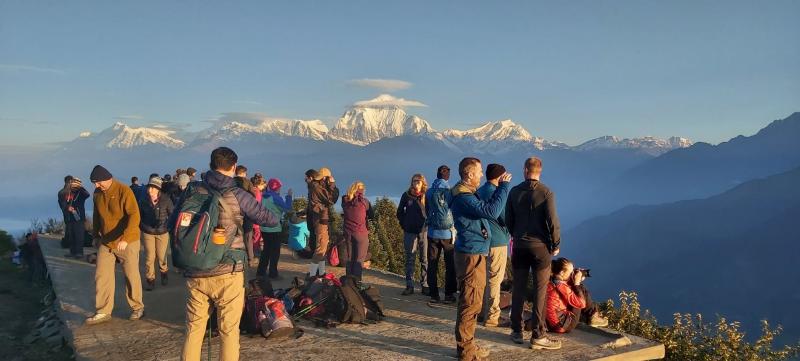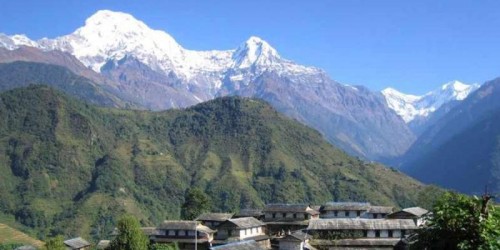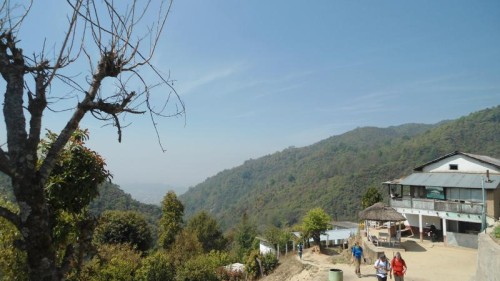Best Time for Poon Hill Short Trek
Generally, the best time for the Poon Hill Short Trek is during the spring (March to May) and autumn (September to November) seasons. These periods offer the most favorable weather conditions, clear skies, and stunning views of the surrounding landscape and the panoramic views of the Annapurna and Dhaulagiri mountain ranges. Winter is also a recommended time due to its not very high elevation. During winter, it is not very cold, and the mountains are covered in snow, providing some of the best views.
Even though the beginning of September to the end of May is a very good time for the Poon Hill Short Trek, it is possible to do the trek throughout the whole year. However, it requires proper preparation, suitable gear, and flexibility to handle the cold weather and shorter daylight hours.
Spring (March to May):
- Weather: Mild and pleasant temperatures.
- Scenery: Rhododendron forests are in full bloom, adding vibrant colors to the trek.
- Visibility: Clear skies provide excellent mountain views.
Autumn (September to November):
- Weather: Stable weather with mild temperatures.
- Scenery: Post-monsoon freshness makes the landscapes green and vibrant.
- Visibility: Crystal-clear mountain views.
While these two seasons are the most popular, the Poon Hill Short Trek, also be done in winter (December to February) and summer/monsoon (June to August), though these times come with certain challenges.
Winter (December to February):
- Weather: Cold temperatures, especially at higher elevations.
- Scenery: Snow-capped peaks and a tranquil environment.
- Visibility: Generally clear skies, but colder and shorter days.
Summer/Monsoon (June to August):
- Weather: Warm temperatures with high humidity and frequent rainfall.
- Scenery: Lush green landscapes, but trails can be muddy and slippery.
- Visibility: Occasional cloud cover may obscure mountain views.
Each season has its unique advantages, but for the best overall experience, spring and autumn are highly recommended. You can choose the best time for the Poon Hill Short Trek based on your vacation schedule.
How to get Poon Hill?
To get to Poon Hill from Kathmandu, there are many different starting and ending points for the trek, and the trekking itineraries are always flexible. It may take a little more or less time than the following itinerary. Generally, the regular starting and ending point of the trek is Nayapul, after reaching Pokhara. Pokhara is one of the fancy, popular tourist cities in Nepal. It is easily accessible from Kathmandu by air or land. Located in the west and 200 km from Kathmandu, Pokhara is the gateway to the Poon Hill Trek and it takes approximately 2-3 days to reach Poon Hill.
Normally, you can take a private or public vehicle along the Pokhara-Baglung road for one and a half hours to Nayapul from Pokhara. From there, you will trek to Ulleri, which is the best place for accommodation and to spend the first night of the trek. The next day, you will reach Ghorepani through the green forests of rhododendron, pine, oak, bamboo, etc. The following morning, you will hike up to Poon Hill (3,210 m) for a sunrise view of the Annapurna and Dhaulagiri mountain ranges. The hiking trail to Poon Hill takes approximately 1.5 hours and covers a distance of about 2 km. After an incredible time at Poon Hill, you will return to Ghorepani for breakfast and then head to your next destination.
Poon Hill Short Trek Difficulty
The Poon Hill Short Trek is considered easy to moderate in difficulty. The walking distances are manageable, taking you through farmland, local villages, and lush rainforests, with a gradual increase in altitude. The trek starts at 1,025 meters in Nayapul or Birethanti, and the highest point is Poon Hill at 3,210 meters. While the trekking trail can be narrow and includes some steep slopes, particularly before and after Poon Hill, it is generally not too strenuous. You will need to walk 5 to 8 hours a day.
The risk of altitude sickness is low on this trek due to the abundance of oxygen and greenery. A strong mindset and determination are key to successfully completing the trek. The Poon Hill Trek is physically possible for all levels of travelers, but some short hiking training beforehand is beneficial.
If you plan to trek during peak season, it is advisable to book accommodations in advance, as there may not be enough available, making it difficult to find good lodging. If you trek in winter, be prepared with warm clothes as the weather can be extremely cold. During the monsoon season, the trail can become slippery and tough due to the rainforest terrain.
It is recommended to book this trip with a reputable trekking agency. They will provide experienced guides and accurate information, enhancing your trekking experience and making it more enjoyable, hassle-free, and memorable.
Poon Hill Short Trek Permit and Cost
Ghorepani Poonhill Trek situated in Annapurna Conversation Area, so you need to buy entrance fee of ACAP (Annapurna Conservation Area Project) permits and TIMS (Trekkers Information Management System) card. Both of these permits are compulsory for your trek to Annapurna Region except Nar Phu Valley Trek and Upper Mustang Trek. Those two permits can buy ether from registered trekking company or Tourism Board (Bhrikuti Mandap). Those two permits, you have to take yourself during the whole trek and have to show on the every check post along the Ghorepani PoonHill Trek. If you are going there without these 2 permits, you have to buy from there with double charge (penalty) or you may have turn back.
TIMS (Trekkers Information Management System) is compulsory for everyone to trek in Annapurna Region.
- Cost US$ 20 per person/ per Trek
Annapurna Conservation Area Project (ACAP) entry permits
- It cost US$ 30 only per person/ per trek
Our government has instilling these two permits for Annapurna Base Camp Trek from Kathmandu and Pokhara.
Food and Accommodation in Poonhill Trek
Annapurna Region is second popular trekking destination in Nepal next to Everest Region. There are many trekking routes and Ghorepani Poonhill Trek is best one of them. Ghorepani Poonhill Trek is short and popular route in the region. This trekking trail is well managed and management by the Annapurna Conservation Area project and local community.
There are lots of accommodations and restaurants along the trekking trail because every year increasing new house and add the room for trekkers. So, you can have easy to finding comfortable accommodation in the Annapurna region. Almost all tea-houses are tried to give you best service for all traveler. Normally, lodges have private rooms (2 beds in one room) for customers with sharing indoor bathroom but if you need luxury lodge, they have luxury facilities and some places have limit lodges. Every different place has different quality of the lodges so, you can choose best on your budget.
Every lodge have food menu and foods items are almost same. We strongly recommended typical Nepali dish “Dal-Bhat” (boiled rice, vegetable, lentil soup) but if you like, you can choose others food from food menu. Most of the lodges produced fresh Vegetables on their garden and serve to costumer. Basically, the cooks are trained but food taste might be bit different than western. Meat is not fresh in the mountain area so you have tried to be vegetarian during the Ghorepani Poonhill trek.
You can buy all types of drink in every lodge but the prices goes high as you go higher. You can drink normal water with using a purification tablets. Avoid the alcoholic drinks when you go higher.
Trekking Gear List
Travel equipment are necessary to pack before you travel. We hope it is too much to carry from your home to others country but some are the necessary equipment can be hired or buy in Kathmandu around Thamel.
These general equipment are for all seasons while on trekking in Nepal, but may be different as per the different season and duration of trekking routes on your chosen trip.
Documents:
- Passport and 4 passport size photos
- Travel insurance details (in case an emergency evacuation if needed)
- Boarding passes for flights
- Driver’s license (if needed)
- Cash USD
- Credit/Debit Card (Ensure you have $500 on your card incase an emergency helicopter evacuation is needed)
Sleeping:
- Sleeping bag (Comfort rating -15 Celsius recommended)
- Sleeping bag liner (Optional)
Footwear:
- Trekking boots: one pair lightweight
- Sandals for city and tea house footwear
- Shoes for the plane and tea houses (Optional)
- Gaiters for hiking in winter to the base camp
- Thin, lightweight inner socks
- Thick, warm wool hiking socks
Clothing for body:
Please make sure that you have non-cotton clothing for trekking.
- Base-layer t-shirts (e.g. running t-shirts)
- Fleece/Windproof jacket
- Waterproof jacket
- Down jacket for warmth
- Travel clothes and City Wear
- Underwear
- Base-layer trousers (optional)
- Waterproof trousers
- Trekking trousers
- Trekking shorts (Optional)
- Gloves and wool hat
- bandanna or scarf
Health Requirements (Basic First Aid Kit)
- First-aid kit; should contain lip salve, Aspirin, Band Aids, anti-histamine, Imodium or similar tablets for mild cases of diarrhea
- Re-hydration powder, extra prescription drugs you may be taking if any particular
- Wet wipes for cleaning can be purchased in Kathmandu
Others:
- Sunglasses and Sun cream
- Towel
- Book (reading and writing materials)
- MP-3 /Music, headphones and ear plug (who know some people on group are snoring) as optional.
- Travel wash
- Hand sanitizer, wet wipes
- A day bag: 35 liters
- A duffel or rucksack with straps to go over your back (Max 12 kg of weight for porters to carry)
- Dry Liner or Dry Bag
- Water bottle/thermos/ camel bag: At least 2 L. Nalgen bottles best.
General Toiletries
- Toilet papers/ tissue
- Contact lenses, Glasses (if needed)
- 1 medium sized quick drying towel
- Tooth brush/paste (preferably biodegradable)
- Multipurpose soaps (preferably biodegradable)
- Nail clippers
- Face and body moisturizer
- Feminine hygiene products
- Small mirror
- On Personal Hygiene
- Wet wipes (baby wipes)
- Anti-bacterial hands wash
Others (optional)
- Trekking Poles
- Large plastic bags – for keeping items dry inside your kit / duffel bag
- Travel game i.e. chess, backgammon, and scrabble. (for luxuries)
- Binoculars (for luxuries)
- Trail Map/Guide book (if you are alone)









 USD 470
USD 470
Vinay Kumar
Australia
Exceptional Trekking Guide- Highly Recommend
14th June, 2023
My friend and I trekked for 5 days in the Annapurna Conservation area, heading up to Poon Hill and back around to Pokhara via Ghandruk. We were accompanied by Purna (one of the owners of High Pass Adventure).
Purna was an exceptional guide! He is very personable and highly flexible. When my friend injured his knee, Purna swiftly changed our itinerary to accommodate his injury and extended the trip by one day - no questions asked.
Wei Han Kho
Singapore
Poonhill Trek
18th June, 2023
I recently did a 4-day-trekking to Poonhill from High Pass Adventure. The trek guide settled everything for us includes meals, accommodation, pass, and potter, basically everything. The tour guide is friendly and always shares some knowledge with me. I would recommend High Pass Adventure for trekking in Nepal or Tibet!! And again I will come Nepal for Everest Base Camp Trek with them.
Christa M
United States
Amazing Trip in Nepal with High Pass Adventure
18th June, 2023
I stayed 2 weeks in Nepal with high Pass Adventures. Everything was perfect - weather, accommodation in both Kathmandu and on our trek, our guide - he was really helpful, enthusiastic and made the whole experience very enjoyable. The trek was planned so that we acclimatized very well and neither I nor my husband suffered with any altitude sickness or tummy bugs. High Pass Adventure organized the whole thing really well and left us nothing to worry about.